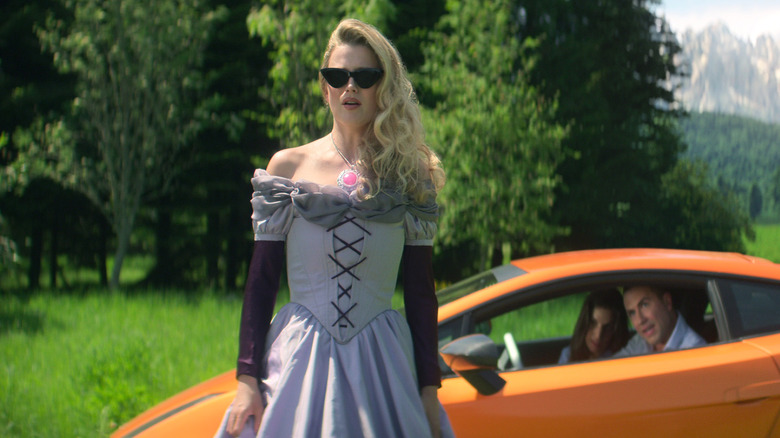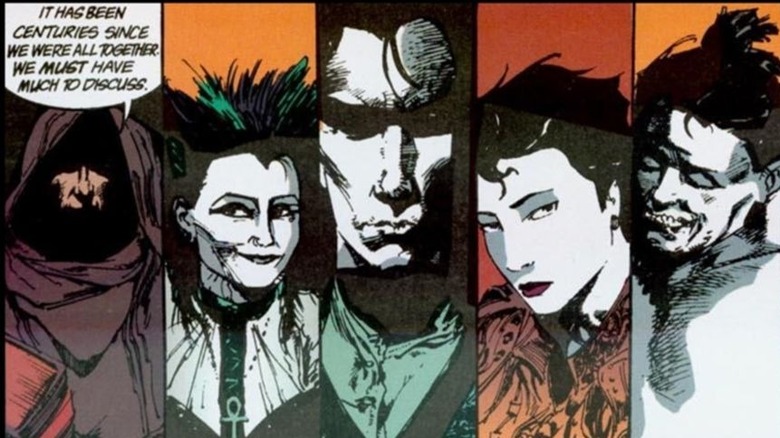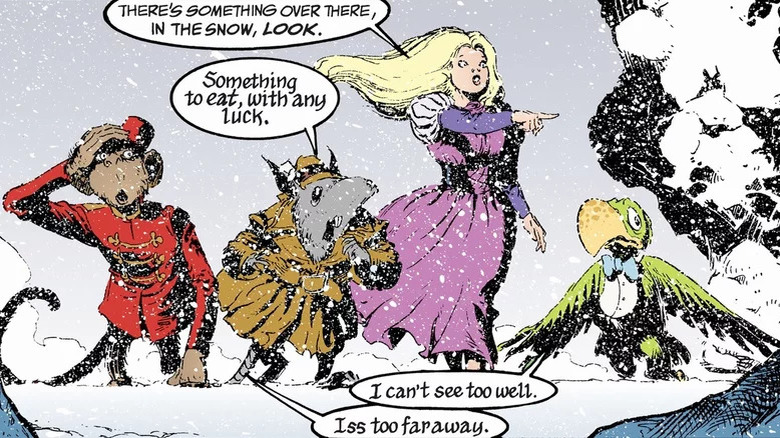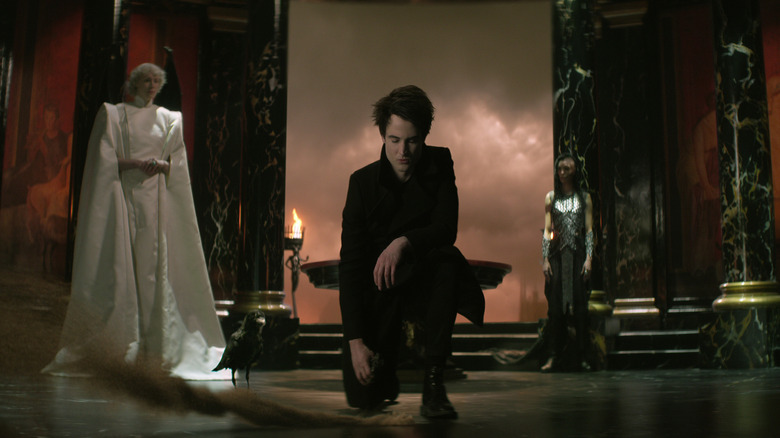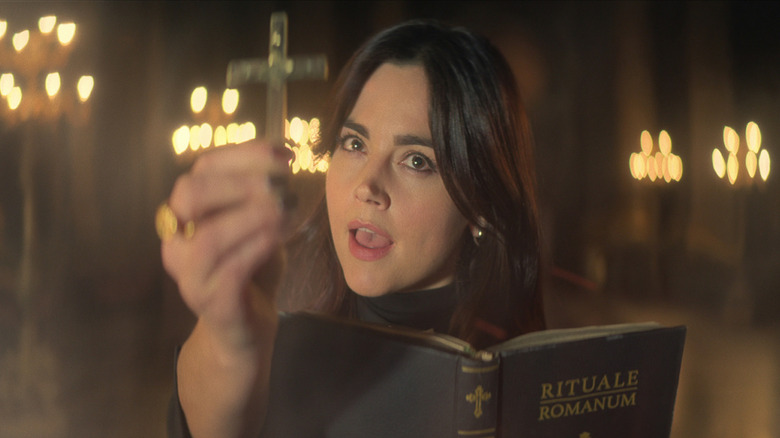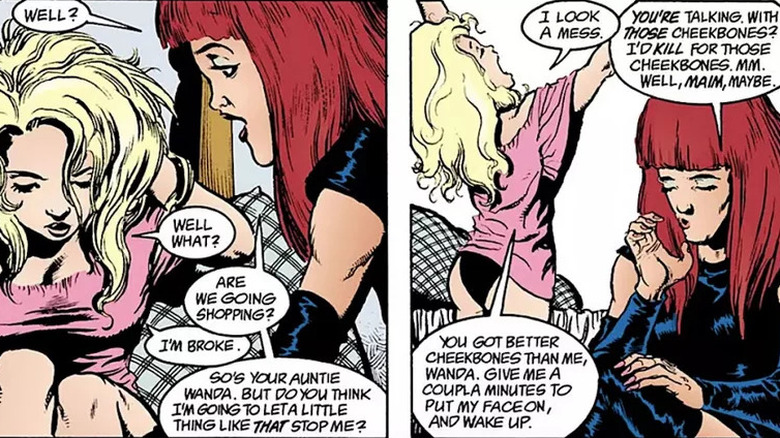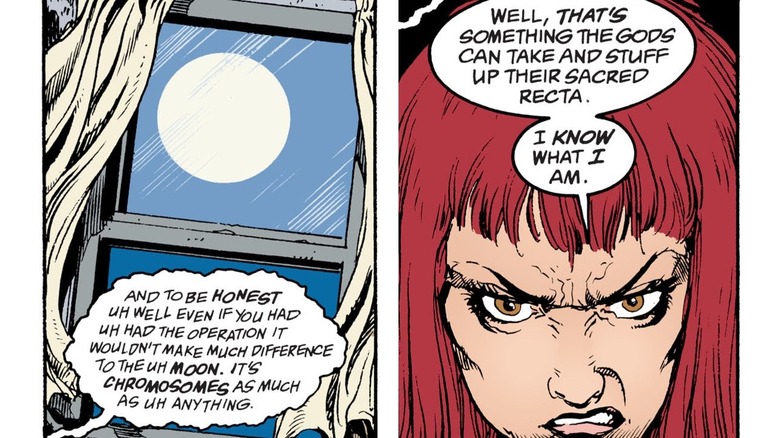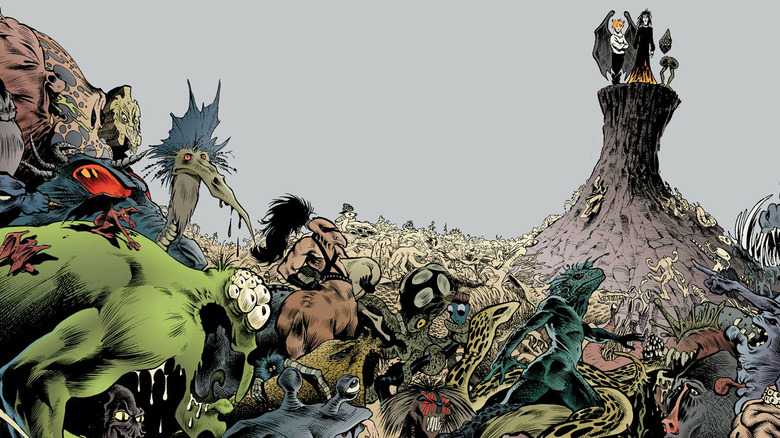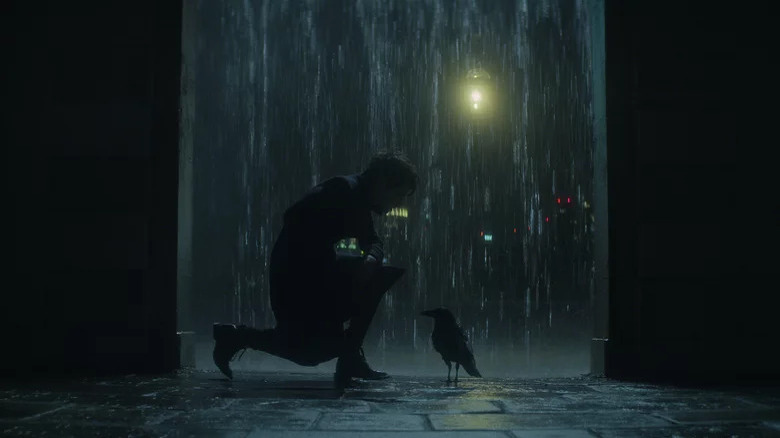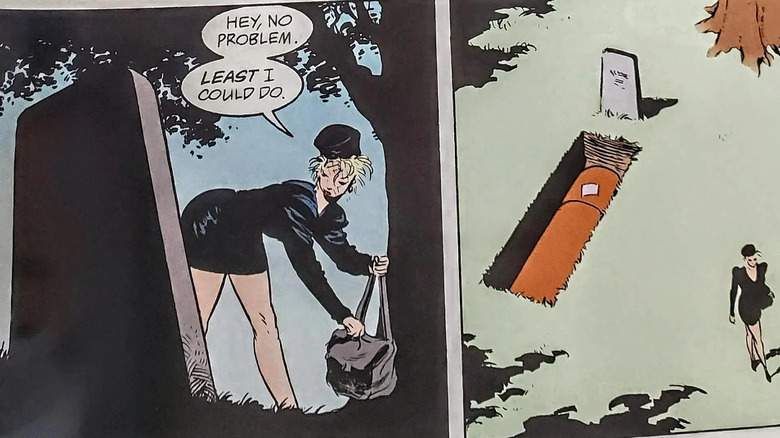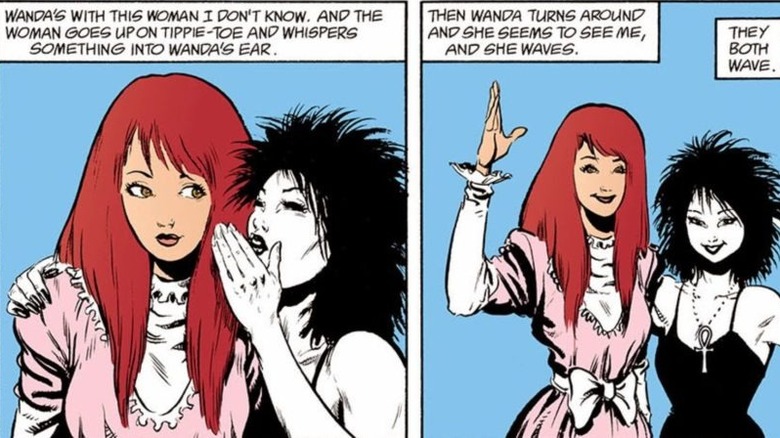How Should The Sandman Season 2 Adapt One Of The Comic's Trickiest Storylines?
This post contains spoilers for the first five volumes of the "Sandman" comics, and will most likely spoil events for the upcoming second season of the show.
It's going to be a while before season 2 of "The Sandman" drops on Netflix, which means we've got plenty of time to speculate on what's going to happen. For fans of the comics, we've already got a pretty good idea: we're definitely going to see the events of "Season of Mists" adapted on-screen, which is bound to be a fun time. We'll get to meet Delirium and Destiny, we'll get to watch as demons escape into the mortal world, and we'll get to see Gwendoline Christie's Lucifer start her own piano bar in Los Angeles. It's gonna be a good time.
What's less certain is the adaptation of "A Game of You." Although we're sure the show has no plans of skipping this fifth volume of the comics altogether, we're not sure about the "when" and "how" of it all. Based on season 1, the safe bet is that season 2 will spend its first half adapting "Season of Mists," have an episode in between that covers some one-off stories from "Dream County" and "Fables and Reflections," and then spend the second half covering "A Game of You."
The problem is that this would make a somewhat lopsided season. "Season of Mists" is a sprawling, epic adventure story, whereas "A Game of You" is a lot more confined. It would seem weird to start the season off with a storyline where the universe is at stake, and then spend the final few episodes on a small-scale plot centered around a handful of mostly new, one-off characters.
A quick recap
"Season of Mists," the fourth volume of the series, starts off with Dream realizing he may have been wrong to send his girlfriend to hell for 20,000 years just because she broke up with him. He decides to journey into hell to rescue her, knowing full well that he might not come back from the journey in one piece. There's a lot of build-up to Lucifer having some big plan for revenge against Dream, but in the end, all he really wants is a break. Lucifer gives up his role as the ruler of Hell, closes the place down, and leaves to wander about and have fun in the mortal world. (Yes, it turns out that was an option this whole time.)
The rest of "Season of Mists" deals with Dream rescuing Nada, and he and all the other mythical beings also try to figure out how to handle the whole Hell situation. There's also a wonderful side story in the middle, where a young boarding school student is trapped over the holidays in a school filled with old spirits escaped from Hell.
The fifth volume, "A Game of You," centers around Barbie, a minor character in "A Doll's House" who TV viewers will remember from season 1. Before Rose's dream vortex took away Barbie's ability to dream, she used to dream of a magical fantasyland, one where the characters inside kept living even when she was awake. In her absence, the world has been taken over by an evil creature from the dream realm called the Cuckoo. With some help from her friends and neighbors (one of whom turns out to be a witch), Barbie returns to the fantasyland in her dream to end the Cuckoo's reign once and for all.
The obstacles for adaptation
There are some issues the show will likely need to take into account with the new season. For instance, several of the characters prominently featured in season 1, like Vanesu Samunyai's Rose Walker or Jenna Coleman's Joanna Constantine, don't make any appearances in "Season of Mists" or "A Dream of You." Lyta Hall (played in the show by Razane Jammal) does make an appearance in "Season of Mists," but only briefly near the beginning. This isn't a big deal for the comics, but it'll definitely feel a little weird for a TV show to straight-up ignore so many prominent actors/characters from its first season.
The other obstacle is the way "A Game of You" portrays and treats Wanda, a prominent trans character who gets killed off near the end. Although Gaiman's support of the LGTBQ+ community has always been reflected in his writing, "A Game of You" has often been criticized for its use of the Bury Your Gays trope, and the way that it seemingly reinforces TERF arguments. As Samuel R. Delany, who wrote the foreword for the book put it, "Here, it turns out, the moon cares whether or not you have a Y chromosome, and punishes you accordingly."
I'd argue that a lot of these criticisms of "A Game of You" fall into the trap of reducing a story to just the tropes it technically fulfills, without exploring its nuances or the context in which it was written. But as Gaiman himself has said: "If I were writing it today, rather than in 1989, when there weren't any trans characters in comics, it would be a different story, I have no doubt." With season 2, we may finally get to see what a 2020s version of the story looks like.
Dealing with the structure
One potential way of approaching season 2 would be to have the storylines occur concurrently, not one after the other. "The Sandman" already sort of did this in season 1; they introduced the storyline where the Corinthian (Boyd Holbrook) was on the loose in the very first scene, and they kept returning to it throughout the first half of the season. When the character became a major player in the second half of the season (when the show reached "The Doll's House," volume 2 of the series), it didn't feel like it came out of nowhere.
Meanwhile, one thing that makes "A Game of You" so unique as a volume is that Dream is barely in it. It centers around human characters dealing with a dream-related problem, and Dream only pops up near the end to put things back in order. This means that the show's writers wouldn't have to change too much to have the events of "A Game of You" take place around the same time as "Season of Mists." It would make sense if the explicit reason why Dream isn't helping out with the situation is that he's too busy dealing with the problems in Hell. It could even make sense if a side villain of the story — the creepy neighbor George who's recruited by the Cuckoo — was rewritten to be one of the demons/souls who escaped from Hell.
There are a lot of fun ways to tie the two volumes together, so it'll be interesting to see how the show chooses to go about it if they do.
Shuffling characters around
When it comes to the problem of season 1 characters getting sidelined, there's the potential solution of moving some of them around and cutting others entirely. One idea brought up by some fans on the Sandman subreddit was replacing Thessaly, the witch who lives in Barbie's apartment complex, with Jenna Coleman's Johanna Constantine.
It's a controversial idea, mainly because Thessaly and Constantine don't have a ton in common besides the fact that they have a special relationship with Dream and they're good with magic. The downside is that it would require major changes to the source material; the upside is that it would give Johanna something interesting to do. (In the comics, John Constantine basically disappears from the series after the first volume, and we only see Johanna Constantine in storylines taking place in the 18th and 19th centuries.)
A less controversial approach would be having Rose visit Barbie when all this crazy stuff goes down and getting wrapped up in the storyline. After all, Rose is another character who season 1 established as being a big deal, even more so than the comics made her out to be. Not to mention, she and Barbie end season 1 on good terms, to the point where it's more than believable they'd stay in touch afterward.
There are no right answers here, of course. Maybe Rose and Johanna won't have anything to do with Barbie's storyline; maybe they'll just get their own small storylines where we see how their lives are affected by Lucifer's big decision. Neil Gaiman has said he's not against writing any original material for the show, so the idea of slipping in a storyline where Johanna deals with some demons again certainly seems possible.
The Wanda of it all
The question that overshadows the rest about adapting "A Game of You" is how to go about the characterization and treatment of Wanda, mainly because few people in the fandom can agree on exactly what should be changed. On the surface, volume 5 is very cruel to its one and only trans character. She's repeatedly misgendered and excluded due to her trans status, even by many of the gods that exist in this universe.
The whole reason Wanda dies in the end is because Thessaly doesn't let her enter Barbie's dreams, and Thessaly (and/or the moon gods) don't consider Wanda to be a woman. This means Wanda is stuck in the waking world when a sudden storm (caused by Thessaly's interference with the moon) knocks down the whole apartment building.
Wanda dies, and the final issue of the volume follows Barbie as she attends Wanda's funeral, held in her hometown in Kansas. Wanda's family cuts her corpse's hair and puts her in a suit, refusing to acknowledge her as anything but a man. There's a sweet moment near the end, after the funeral, where Barbie writes Wanda's real name in lipstick on her gravestone, but as Delany acknowledges in the book's forward, "The first rain will probably obliterate it, and likely no one in Kansas will ever know."
To keep the transphobia, or not to keep it
When discussing the show, it's not uncommon for fans to hope the writers will sidestep a lot of the transphobia within the comics altogether. Some hope that the show will provide a different explanation for why Wanda won't enter the dream world with the other women. Some hope that the writers will subvert the Bury Your Gays trope altogether.
But for better or worse, taking away the hardships Wanda suffers as a result of being trans would be taking away the core of what the volume's about. "A Game of You" is all about the question of identity, reflecting on what to do when the powers that be — even the literal, immortal gods — reject you for who you are. Gaiman takes the stance that trans people would still be valid even if God himself came down to Earth and officially declared otherwise, and he shows this by having Wanda never waver from her belief that she's a woman, even after her death.
Some might argue that the text's critiques of transphobia aren't persuasive enough, but it's a little reductive to look at a book just in terms of how much it works as a vehicle for activism. "A Game of You" was primarily written for an audience that presumably already agrees that transphobia is wrong; the comics had always been far queerer than most mainstream comics of the time, after all. Instead of trying to convince that type of reader, Gaiman seemed to be more interested in exploring the difficulty and danger that so many trans people deal with on a daily basis in the face of relentless bigotry. The self-assured way the comics go about this theme is something I hope the show can stay true to.
The comics' patient, self-assured approach
As I've argued before, a big problem with "The Sandman" TV series so far is the way it sands off all the source material's rough edges. Comic Dream sentences Alex Burgess to nearly-eternal torture at the end of the first issue; TV Dream simply puts him in a coma. The comics tell us what the suicide forest in Hell is all about; the show keeps it vague. Many of the changes aren't a big deal — some of them are probably for the best — but there does seem to be a tendency on the show to shy away from anything that might make the audience too uncomfortable.
The comics were never afraid to go there; the TV show often is.
More than anything, the comics were comfortable with the possibility of being misunderstood. For instance, the suicide forest introduced in the first few issues, inspired by Dante's "Inferno," is originally depicted in a way that has a cruel, terrifying message. The reader's introduced to the apparent concept that those who commit suicide are doomed to suffer for all eternity as punishment, and the text itself depicts this in what could be seen as an apathetic way, as if it's saying this outcome is fair. It's only three volumes later in "Season of Mists" that the series returns to the concept and paints it in a more nuanced, hopeful light. The comic trusts its audience not to rush to any conclusions and later rewards them for their patience.
A less confident show
The show, like plenty of other TV shows, seems less comfortable with this sort of thing. It's easy to see a version of season 2 where the writers feel the need to explicitly, repeatedly confirm to viewers that we're supposed to agree with Wanda and Barbie's perspectives, a version where Barbie triumphantly tells off Wanda's family at the end instead of resisting in quieter ways.
Maybe it's a result of social media making it more visible than ever just how many right-wing viewers can vastly misunderstand the social commentary within the shows and films they consume, but it feels like TV writers are often so afraid of being misunderstood that they end up creating a story that lacks any nuance and reeks of self-consciousness. Would Netflix's "The Sandman" feel comfortable trusting its audience to know that when Thessaly calls Wanda a man, we're not supposed to take the moment as a representation of the writers' views? Or would it feel safer cutting the line altogether?
In a world where reactionaries have managed to profoundly misinterpret and claim ownership of movies and shows like "The Matrix," or "The Wire," we hope "The Sandman" doesn't fall into the trap of trying in vain to make idiot-proof social commentary. It's an impossible goal that's not worth pursuing, one that limits the level of depth the story's capable of reaching.
Looking beyond tropes
One pervasive problem in online media criticism is a tendency to reduce stories to the tropes they include, and things can get particularly reductive when it comes to queer movies and shows. Queer audiences are often (very, very understandably) easily frustrated and turned off by shows and movies that use the Bury Your Gays trope, especially after 2016 when seemingly every major TV show was killing off its queer characters left and right.
But you'll occasionally hear the argument that it's morally wrong for an artist to kill off a queer character, no matter what. Regardless of the context, regardless of the artist's message, or the time the story was written. It's an idea I find frustrating in part because it always feels reductive to try to apply a hard and fast rule to writing fiction, but also because it's an attitude that falls apart the moment you enter the horror genre. Killing characters off (or just making it believable that characters are in mortal danger) is an important part of most horror fiction, and sticking to a rigid refusal of anything resembling this trope isn't healthy.
That's not to say that Wanda's death, and the comics' handling of it, isn't above criticism. However, her death is a core part of what the story's about. Whatever alterations the show makes to the source material, hopefully they understand that Wanda's heartbreaking death isn't something that can be changed. As Vox writer and culture critic, Emily St. James put it, "Saying queer characters can't die in a story is limiting the kinds of stories that can be told about us and ultimately shoving us in a very different closet. Sometimes a queer character has to die for the story. That's okay!"
At least we know they'll keep the closing note
The clearest piece of evidence that "A Game of You" is not a transphobic text is the final page, where Barbie sees a vision of Wanda and Death. Death is a character who, in the "Sandman" universe at least, is one of the most trustworthy, morally-upstanding people you can ever meet. She's been right about basically everything, so there's no reason to think she's wrong when she basically declares, as the volume's final word, that Wanda really is a woman, regardless of anything her family or the other gods have said.
It's a great note to end on not just because of its message, but because it's a reminder of another limitation of the Bury Your Gays discourse around the "Sandman" series. Dying, in this universe, is explicitly, and repeatedly established as not a tragic thing. Death is personified as a friendly goth woman, after all; we don't know exactly what happens after she takes you into the land of the dead, but we know it's far less scary than the land of dreams.
"A Game of You" might be my favorite volume in the series simply because of how introspective and human it is. In a series that's mostly about beings who are fundamentally disconnected from humanity, "A Game of You" is one of the only volumes that's almost completely focused on the lives of regular mortals, who are in a constant struggle to maintain a sense of self in a cruel, chaotic, confusing world. There are a million different ways the show can go about adapting this volume, but with Gaiman involved and multiple trans writers in the writers' room for season 2, we've got plenty of reasons to expect something great.
